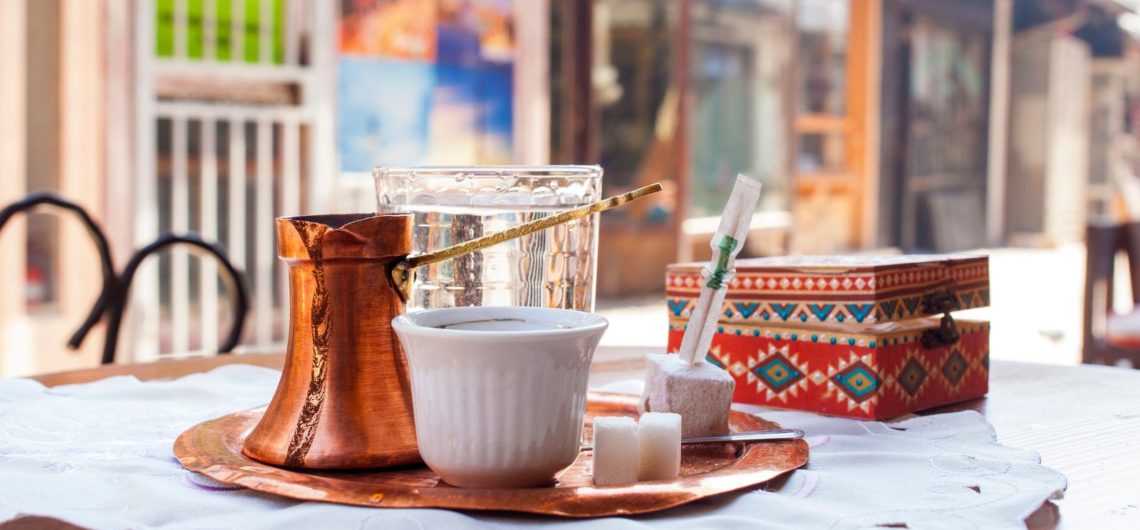Coffee is the cornerstone of Bosnian culture and has been since the Ottomans introduced it in the 15th century. But make no mistake, it is not the same as Turkish coffee. Order the latter at a cafe in Sarajevo and you’ll soon be corrected.
Tasting Bosnian coffee (Bosanska kahva) is a must-do experience during your trip to Bosnia and there’s a certain ritual to follow. So to ensure you er… blend in with local connoisseurs, we’ve drafted in an expert. Enter Skender, our amazing guide in Bosnia.
There’s nothing Skender doesn’t know about Bosnian coffee and if you’re joining one of our guided holidays there, you’ll get the full demonstration.
What is Bosnian coffee and how is it made?

Bosnian coffee is a strong, unfiltered coffee which is so thick you could almost chew it. It’s served with sugar cubes and a sweet similar to Turkish delight called rahat lokum.
There’s a science to making the ideal brew, explains Skender.
‘The water needs to be heated to a temperature between 93℃ and 95℃ in a pot traditionally called a šerbetnjak.
‘After the water reaches the required temperature, coffee is placed in the special copper pot, which we call đezva. The amount of coffee varies depending on personal preferences and the desired strength of coffee.
‘The đezva is returned to the heat source and held for a few moments to warm the bottom of the pot. This step allows the coffee to begin to develop its full aromatic profile. Then the water is carefully poured over the coffee, which achieves the characteristic “pop” sound. This sound is an important part of the tradition and symbolises that the coffee is properly prepared.’
‘After pouring the water, the đezva returns to the heat until the coffee boils. This step requires attention because the coffee rises quickly and it is important to prevent it from boiling over.’
Bosnia and Herzegovina holidays
7-Day Multi Activity Holiday in Bosnia and Herzegovina
We start in Sarajevo before retreating to the glorious Dinaric Alps for hiking, kayaking and pottery making. And because you can’t visit Bosnia without seeing Mostar’s charming Ottoman bridge, we’ve pencilled in time for that too.
What’s the difference between Bosnian and Turkish coffee?
To the untrained taste buds, Bosnian and Turkish coffee tastes pretty much the same. But there are a few differences in the prep and presentation, as Skender explains.
Both begin by pulverising coffee beans into a fine powder, but the similarities stop there.
‘Lighter coffee is used in Bosnia while darker coffee is used in Turkey, meaning Bosnian coffee has a lighter taste.’
While the Bosnians boil the water and then add the coffee, the Turks put the coffee and sugar into cold water and boil it all together.

Also, Bosnian coffee is served to the customer in the džezva on a round iron tray with a traditional ceramic cup (fildžan), a glass of cold water, a small bowl of sugar cubes and a piece of rahat lokum. Whereas in Turkey, expect to just receive the cup of coffee already poured for you while the džezva (cezve in Turkish) stays behind in the kitchen.
Related posts:
How to drink Bosnian coffee the right way
Bosnian coffee is designed for leisurely sipping and locals can while away hours drinking it (the copper džezva keeps it hot). Don’t be surprised if your coffee comes with a cigarette and match too, particularly in Sarajevo.
‘An important part of the tradition is the order in which the coffee and side dishes are consumed,’ says Skender. ‘Once the coffee is prepared in the džezva, after thoroughly stirring, you would leave it a few minutes to settle in the džezva and then pour it into the fildžan.’ While your coffee settles, you eat your rahat lokum.
‘Next, a sugar cube is dipped in the coffee, bitten off, and then washed down with a sip of coffee. This procedure enables a reduced intake of sugar and a better experience of enjoying the taste of coffee,’ explains Skender.

Srkati
If you really want to gain the respect of locals, you can adopt the traditional way of sipping your coffee, which is called srkati.
‘Sipping coffee by srkati is part of the enjoyment and culture and also helps in cooling the coffee faster,’ says Skender. ‘By srkati coffee, you actually do not touch the cup directly by the lips, but sip the coffee by bringing the cup closer to the lips, and strongly pulling in the air with coffee alongside.’
Tanka or jaka?
According to Skender, the traditional moon and star design in the bottom of the fildžan is an indicator of how strong your coffee is. If you see the image at the bottom of the fildžan, your coffee is tanka, meaning light/weak and if you can’t, your coffee is jaka (strong).

‘In the olden days, there used to be a difference between male and female fildžan. Men used to drink stronger coffee with everyone they would meet during the day, so men’s fildžan used to be smaller. Female fildžan used to be bigger and women would often drink lighter coffee or would add some milk.’
So there you have it. The ultimate guide to Bosnian coffee. Thanks Skender for helping us tackle this one!
Tip – Want to make Bosnian coffee at home after your trip? If you’re visiting Sarajevo‘s Ottoman quarter, you can pick up a hand made copper coffee set on Kazandžiluk (which literally translates to ‘Copper Street’) and take it home with you.



Comments